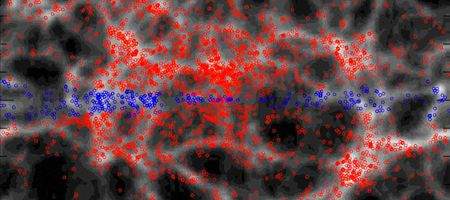German astronomers have created an artificial intelligence algorithm to help chart and explain the structure and dynamics of the universe more accurately than ever before.

It’s not easy to explain the large-scale structure of the universe, driven by gravity, with its galaxy clusters, connecting filaments and large empty regions.
Gravitation originates from two components: the 5 percent of the universe that appears to be made of ‘normal’ matter, and the 23 percent made up of invisible ‘dark’ matter. Alongside these, some 72 percent of the cosmos is made up of dark energy, thought to be responsible for accelerating the expansion of the universe.
These three constituents are described in the Lambda Cold Dark Matter (LCDM) model for the cosmos, the starting point for the work of the Potsdam team. But while matter and dark matter in our Local Group of galaxies are relatively easy to deal with, it’s been impossible to accurately map the dark matter in the same region.
“Finding the dark matter distribution corresponding to a galaxy catalogue is like trying to make a geographical map of Europe from a satellite image during the night that only shows the light coming from dense populated areas,” says Dr Francisco Kitaura of the Leibniz Institute for Astrophysics.
To try to solve this problem he developed a new AI-based algorithm that starts with the fluctuations in the density of the universe seen in the Cosmic Microwave Background Radiation (CMBR).
It then models the way that matter collapses into today’s galaxies over the subsequent 13 billion years – and produces results that are a close fit to the observed distribution and motion of galaxies.
“Our precise calculations show that the direction of motion and 80 percent of the speed of the galaxies that make up the Local Group can be explained by the gravitational forces that arise from matter up to 370 million light years away” says Kitaura.
“In comparison, the Andromeda Galaxy, the largest member of the Local Group, is a mere 2.5 million light years distant, so we are seeing how the distribution of matter at great distances affects galaxies much closer to home.”
To explain the rest of the 20 percent of the speed, he says, it will be necessary to consider the influence of matter up to about 460 million light years away.
“Despite this caveat, our model is a big step forward. With the help of AI, we can now model the universe around us with unprecedented accuracy and study how the largest structures in the cosmos came into being,” he says.






